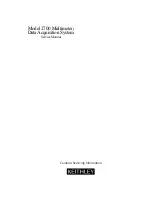
Chapter 4 Operation
MX-2100/2104
Installation and Operation Manual
4-4
MX-2100 Supervision Language
•
After the command is executed, a time stamp is displayed in the following
format:
time: HH:MM:SS date: DAY MMM,DD,YYYY
•
where
MMM
is written as JAN, FEB, etc.
DAY
is written as SUN, MON, etc.
•
The supervisory port prompt (
KM2100
>
) is displayed on the line following the
time stamp.
Command Fields
•
When a command has several fields, use the space bar to move the cursor
among the various fields. However, for some commands, the ENTER key is
used instead. This is indicated in the command description.
•
When a field has a limited range of values, the available values can be
displayed by scrolling. Scrolling is performed by bringing the cursor to the
desired field, and then pressing the F (forward) or B (backward) key until the
desired value is displayed.
•
If a certain field is not applicable to the current command, the field shows
N/A
and scrolling is not possible.
N/A
will appear in fields of a DEF command that
specify parameters not used in the selected operating mode.
Ending a Session
•
If an idle disconnect time-out is specified, MX-2100 will automatically
disconnect the ongoing session if no command is received from the terminal
for the specified time-out interval.
•
The EXIT command disconnects the supervisory port and transfers the control
to the front-panel LCD and push-button.
After ending a session by the EXIT command, you can press any alphanumeric
or editing key to start a new session. It is recommended to press the ENTER
key.
Index of Commands
Table 4-2
lists the MX-2100 commands in alphabetical order. Note that some
commands have both a longhand and an abbreviated format.
Table 4-2. MX-2100 Command Set Index
Command Purpose
Options
BYE
Return control to the MX-2100 front panel at the end of a TELNET
session.
CLR ALM
Clear alarms stored in the MX-2100 alarm buffer
/A
CLR LOOP
CLR LP
Clear user-initiated loops or tests
















































